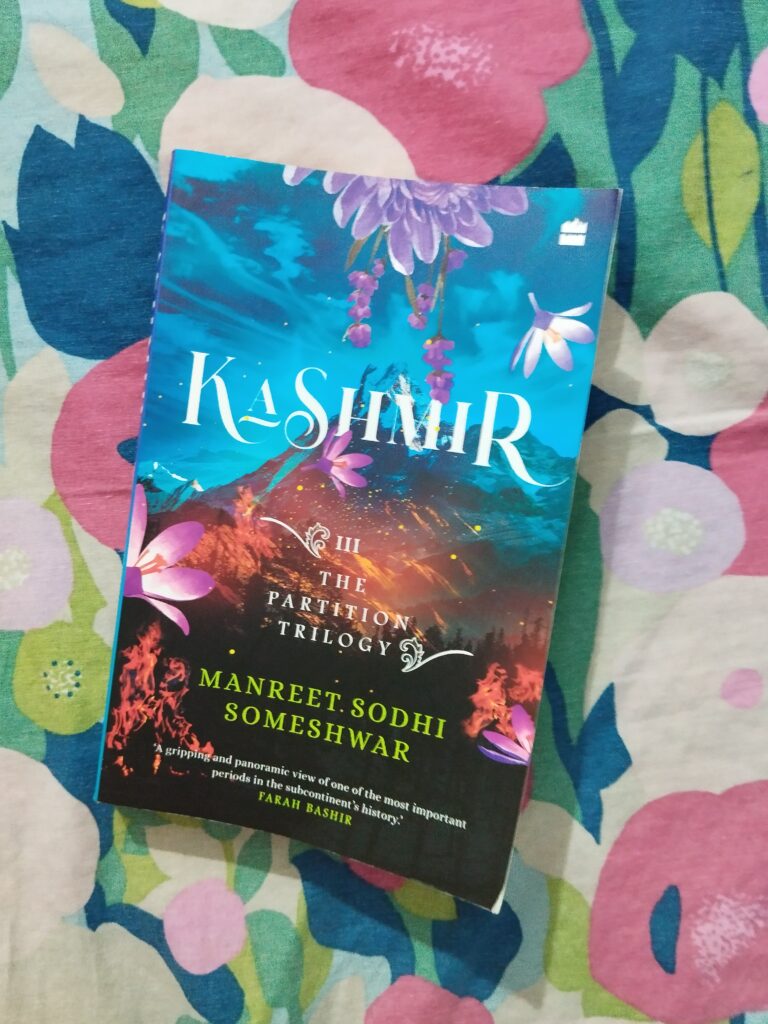My first book of 2024 is ‘Kashmir’ by Manreet Sodhi Someshwar, which is book three of her Partition Trilogy published by HarperCollinsIndia. Each book of the trilogy can be read as a standalone book. This is the first time I’m reading a book by the author.
‘Kashmir’ can be described as a literary political thriller set in the months leading up to 1947(the year of India’s independence) and later. The author has combined elements of fiction with real events that have taken place to produce this novel. She covers the cast of characters and includes a map of Kashmir at the beginning of her book, but no glossary is provided for the many local terms that are used.
The book opens with Viceroy Mountbatten visiting Maharaja Hari Singh to discuss Kashmir. Not much discussion takes place. As tension mounts in Kashmir as to which country it must be annexed with – India or Pakistan – the peace in the valley is disrupted and it leads to fighting. Different factions fight with each other to lay claim to Kashmir, and the bodies keep piling up.

Book Cover of Kashmir
Amidst the political turmoil, we are introduced to Margot Parr, an American journalist who wants to cover stories from the valley for her readers in America.
We come across several characters who are separated from their families, trying to make sense of the new world that they have been thrust into – a world of fighting, savagery, and rape, with rivulets of blood flowing everywhere.
There was a glimmer of hope amidst all this. But then, as the weather changed, there were snowstorms, avalanches, amputation, and other horrors to contend with for the Indian soldiers fighting in these severe weather conditions – fighting against the Pakistanis who flooded in and persisted against all odds. There were camps where abducted women tried to get back their spirit to live after atrocities were committed against them.
Some of the women who got back “safely” had mutilated hands, their ears were cut off, and they were disfigured in other ways. They all had recurring nightmares and post-traumatic stress disorder. Self-defense classes were held for the women and they trained so that they could defend themselves against the marauders.
Amidst all this, Sardar Vallabhai Patel put in his resignation due to a difference in ideologies from Pandit Jawaharlal Nehru. The United Nations, freshly created after World War Two, was asked to intervene and keep the peace.
While there is a mix of real people from history and fictional characters introduced in the novel, I enjoyed the fictional characters more. In this book, I found the character of Zooni especially interesting. She displays bravery and strength. Most of the women characters reveal their fortitude and resilience throughout the book, despite the patriarchal set-up. The scenes involving Zooni would translate well to a screen adaptation if it were to occur. The scene involving the Himalayan Griffon Vulture would also look amazing on screen. I skimmed through some of the political and military strategy details and appreciated the more human aspects of the storytelling. The unspeakable atrocities on women in the aftermath of the partition of British India, which brutally divided the Hindu and Muslim communities, are well brought out.
I think books such as these are interesting to the general reader because they bring alive history and make it captivating for the present generation.
‘This review is powered by the Blogchatter Book Review Program.’ – https://www.theblogchatter.com/book-review-program-from-blogchatter
Here is the Amazon link to buy the book – https://www.amazon.in/Kashmir-Book-3-Partition-Trilogy/dp/9356995400/












2 Responses
Such an informative book. Would love to read it. Thanks for the review. It will give a lot of information to Gen Z about Kashmir.
@Atish – I’m glad you are interested in reading the book. Thank you for leaving a comment.